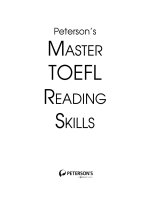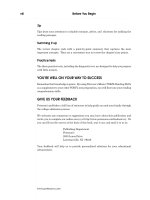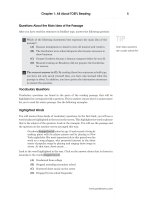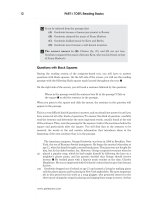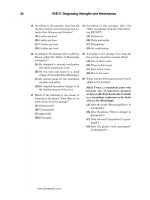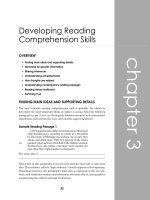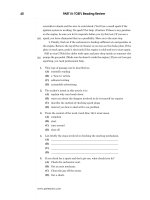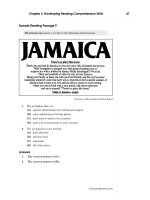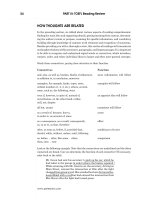Peterson’s master toefl reading skills part 13 pptx
Bạn đang xem bản rút gọn của tài liệu. Xem và tải ngay bản đầy đủ của tài liệu tại đây (70.45 KB, 7 trang )
Chapter 3: Developing Reading Comprehension Skills 75
www.petersons.com
Answers
1. A new ailment has developed among subway users. It is stated in the first
sentence.
2. (A) New ailment called subway syndrome.
(B) Causes people to turn pale and cold and even to faint.
(C) Commuters rush to the hospital, thinking they are having a heart attack.
3. Various and sundry things make people sick on subways. It is stated.
4. (A) Dizziness is caused by not having eaten a proper breakfast.
(B) The overcrowding causes claustrophobia, which brings on stress and
anxiety.
(C) People are afraid of mechanical failure, fire, and/or crime, so they panic.
(D) Men show panic by having chest pains, women by becoming hysterical.
(E) Overcrowding of both sexes, continual increase in the number of
passengers, and people’s inability to avoid interacting with strangers
contribute to stress.
5. There are measures commuters can take to protect themselves from subway
syndrome.
6. (A) Eat a good breakfast.
(B) Concentrate on pleasant thoughts.
(C) Bounce a bit on your toes.
(D) Roll your head.
7. The correct answer is (C).
8. The correct answer is (D).
9. The correct answer is (D).
10. The correct answer is (C).
03_TOEFL Reading Ch 3,31-91 7/29/06, 12:0075
76 PART III: TOEFL Reading Review
www.petersons.com
EXERCISES: UNDERSTANDING CONTEMPORARY
READING PASSAGES
Directions: The passages below are followed by questions based on their content.
Answer the questions on the basis of what is stated or implied in the passages.
QUESTIONS 1–5 ARE BASED ON THE
FOLLOWING PASSAGE.
Not since Americans crossed the conti-
nent in covered wagons have they exer-
cised and dieted as strenuously as they
are doing today. Consequently, they do
not only look younger and slimmer, but
feel better. Because of increased physi-
cal fitness, life expectancy in the nation
has risen to seventy-three years, with
fewer people suffering from heart dis-
ease, the nation’s number one killer.
Jogging, the easiest and cheapest
way of improving the body, keeps more
than 30 million people of all ages on the
run. For the price of a good pair of run-
ning shoes, anyone anywhere can join
the race.
Dieting, too, has become a national
pastime. Promoters of fad diets that
eliminate eating one thing or another,
such as fats or carbohydrates, promise
as much as 20-pound weight losses
within two weeks. Books describing
such miraculous diets consistently
head up the best-seller lists because
everybody wants to lose weight quickly
and easily.
Nevertheless, both jogging and diet-
ing, carried to extremes, can be hazard-
ous. Many confused joggers overdo and
ultimately suffer from ankle and foot
damage. Fad dieting, fortunately, be-
comes only a temporary means for shed-
ding a few pounds while the body is
deprived of the balanced nutrition it
requires, so most dieters cannot perse-
vere on fad diets. Above all, common
sense should be the keystone for any
dieting and exercise scheme.
1. The main idea of paragraph 1 is
(A) Americans got exercise when they
crossed the continent in covered wagons
(B) exercise and diet are more widespread
in America than ever before
(C) heart disease is the number one killer
among Americans
(D) Americans live longer than they did
before
2. The main idea of paragraph 2 is
(A) jogging as an exercise appeals to a
large number of Americans
(B) joggers have to buy special shoes
(C) joggers must be a certain age
(D) jogging is inexpensive
3. The main idea of paragraph 3 is
(A) people are so eager to lose weight that
they will try any kind of diet
(B) fad diets are so popular because they
are on the best-seller lists
(C) eliminating fats or carbohydrates will
cause drastic weight loss
(D) diet books guarantee 20-pound weight
losses
4. The main idea of paragraph 4 is
(A) it’s good for you to jog and restrict
your eating
(B) improperly controlled, diet and exer-
cise harm rather than benefit your
health
(C) jogging can damage the body because
it is too strenuous an exercise
(D) in the long run, dieting doesn’t help
people reduce because they don’t stay
on a diet
(5)
(10)
(15)
(20)
(25)
(30)
(35)
03_TOEFL Reading Ch 3,31-91 7/29/06, 12:0076
Chapter 3: Developing Reading Comprehension Skills 77
www.petersons.com
5. You can infer from this passage that
(A) a person’s life expectancy depends
upon diet
(B) inactive and corpulent people are
prone to heart disease
(C) more people succumb to heart disease
than to any other ailment
(D) All of the above.
The cost of medical services has a di-
rect influence upon the cost of other
things Americans purchase. Large com-
panies provide health plans for their
employees, and, as the premiums rise
for those plans, the manufacturers must
cover their expenses by increasing the
sales price of their products. One auto-
mobile manufacturer, for example, esti-
mates that the soaring costs of health
insurance have added $350 to the cost of
a car. Health costs are not isolated but,
rather, have had an increasingly appall-
ing effect upon the rate of inflation.
6. _______________ of all Americans have
health insurance.
7. The rate of inflation in 1981 was ______.
8. Medical costs in 1981 rose ____________.
9. The average cost per person in the
United States for medical care was
_______________.
10. Medical plans pay up to _______________
in reimbursements to participants.
exercises
Directions: Scan the passage as quickly as possible to get the information required
to fill in the blanks in the following sentences.
QUESTIONS 6–10 REFER TO THE FOLLOWING
PASSAGE, WRITTEN IN 1983.
The statistics relating to the skyrock-
eting costs of treating the sick indicate
that there is no easy cure for inflation
in America. Health costs rose 15.1% in
1981, whereas the inflation rate was
only 8.9%. The entire nation spent ap-
proximately $287 billion on health care,
an average of $1,225 per person. Since
85% of all Americans are covered by
health insurance and get reimburse-
ments of up to 75%, there are no incen-
tives for reducing costs. Medicare and
Medicaid, programs for the poor and
the elderly, paid out $73 billion in 1981,
an increase of $30 billion over the cost
in 1976.
Between 1972 and 1982, hospital care
costs quadrupled to $118 billion; doc-
tors’ services tripled to $54.8 billion; and
nursing home costs quadrupled to $24.2
billion. A day in a hospital cost $133 in
1975; in 1982, the price was $250. There
are multiple causes for soaring medical
costs. New construction, particularly
when special highly technical areas like
burn centers are required, has escalated
in cost. To keep a patient alive with
modern mechanisms like the kidney di-
alysis machine costs an added $9 million
a year nationwide. The more highly tech-
nical treatment becomes, for example
for heart and other organ transplants,
the more impossible it becomes to halt
the inflationary rise of medical costs.
(5)
(10)
(15)
(20)
(25)
(30)
(35)
(40)
(45)
03_TOEFL Reading Ch 3,31-91 7/29/06, 12:0077
78 PART III: TOEFL Reading Review
www.petersons.com
ANSWER KEY
1. B 6. 85%
2. A 7. 8.9%
3. A 8. 15.1%
4. B 9. $1,225
5. D 10. $287 billion
03_TOEFL Reading Ch 3,31-91 7/29/06, 12:0078
Chapter 3: Developing Reading Comprehension Skills 79
www.petersons.com
READING HISTORY TEXTBOOKS
When reading historical material, it is crucial to understand cause and effect relations,
chronological sequence, and comparison/contrast. As you work through these passages
and accompanying exercises, keep in mind that it is not necessary to remember the
specific information given here. Your purpose should be to develop the skills and
strategies necessary for effective study reading.
Sample Reading Passage 20
The Olympic Games originated in 776 B.C. in Olympia, a small town in Greece.
Participants in the first Olympiad are said to have run a 200-yard race, but as the
Games were held every four years, they expanded in scope. Only Greek amateurs
were allowed to participate in this festival in honor of the god Zeus. The event
became a religious, patriotic, and athletic occasion where winners were honored
with wreaths and special privileges. There was a profound change in the nature
of the Games under the Roman emperors. After they became professional circuses
and carnivals, they were banned in 394 A.D. by Emperor Theodosius.
The modern Olympic Games began in Athens in 1896 as a result of the initiative
of Baron Pierre de Coubertin, a French educator whose desire was to promote
international understanding through athletics. Nine nations participated in the
first Games; over 100 nations currently compete.
The taint of politics and racial controversy, however, has impinged upon the
Olympic Games in our epoch. In 1936, Hitler, whose country hosted the Games,
affronted Jesse Owens, an African American runner, by refusing to congratulate
Owens for the feat of having won four gold medals. In the 1972 Munich Games, the
world was appalled by the deplorable murder of eleven Israeli athletes by Arab
terrorists. The next Olympic Games in Montreal were boycotted by African
nations; in addition, Taiwan withdrew. In 1980, following the Soviet invasion of
Afghanistan, sixty-two nations caused great consternation to their athletes by
refusing to participate in the Games. The consensus among those nations was that
their refusal would admonish the Soviets.
1. The first Olympic Games were held
(A) for political reasons
(B) as an international competition
(C) as a religious festival
(D) as a professional athletes’ competition
2. Why were the Games discontinued?
(A) They had ceased to be sports events.
(B) The Romans did not enjoy them.
(C) The emperors hated athletes.
(D) Winners were getting special privileges.
(5)
(10)
(15)
(20)
03_TOEFL Reading Ch 3,31-91 7/29/06, 12:0079
80 PART III: TOEFL Reading Review
www.petersons.com
3. Olympic Games are held
(A) every decade
(B) biannually
(C) every four years
(D) perennially
4. The Greek Olympic Games were __________ in nature.
(A) religious
(B) national
(C) athletic
(D) All of the above.
5. The Games were resumed in modern times for the purpose of
(A) giving amateur athletes a chance to participate
(B) promoting goodwill among nations
(C) creating an apolitical arena
(D) None of the above.
6. You can infer that the athletes in sixty-two nations in 1980 were
(A) terribly disappointed
(B) very happy
(C) participants
(D) boycotted
7. The last three Olympic Games mentioned in the passage were notorious
for their
(A) racial discrimination
(B) triumphant victories
(C) fidelity to the goals of the Olympic Games
(D) political controversy
Answers
1. The correct answer is (C).
2. The correct answer is (A).
3. The correct answer is (C).
4. The correct answer is (D).
5. The correct answer is (B).
6. The correct answer is (A).
7. The correct answer is (D).
03_TOEFL Reading Ch 3,31-91 7/29/06, 12:0080
Chapter 3: Developing Reading Comprehension Skills 81
www.petersons.com
Sample Reading Passage 21
When Christopher Columbus landed on America’s shores, he encountered
copper-skinned people whom he promptly called “Indians.” Mistaken in his
geography, he believed he had reached India. Current estimates indicate that
there were over a million Native Americans inhabiting North America then. There
are approximately 800,000 Native Americans today, of whom about 250,000 live
on reservations.
The early settlers had an amicable relationship with Native Americans, who
shared their knowledge of hunting, fishing, and farming with their uninvited guests.
Antipathy developed between the Native Americans and the settlers, whose
encroachment on Native American lands provoked an era of turbulence. As early
as 1745, Native American tribes coalesced to drive the French off their land. The
French and Indian War did not end until 1763. The Native Americans had
succeeded in destroying many of the Western settlements. The British, superfi-
cially submissive to the Native Americans, promised that further migrations west
would not extend beyond a specified boundary. However, there was no holding
back ardent adventurers like Daniel Boone, who ignored the British covenant with
the Native Americans and blazed a trail westward.
Evicted from their lands or, worse still, ingenuously ceding their property to the
whites for a few baubles, Native Americans were ruthlessly pushed west. Tempes-
tuous wars broke out, but lacking their former stamina and large numbers, the
Native Americans were doomed to capitulation. The battle in 1876 at Little Big
Horn River in Montana, in which Sitting Bull and the Sioux tribes massacred
General Custer’s cavalry, caused the whites to intensify their campaign against
the Native Americans. The battle at Wounded Knee, South Dakota, in 1890
rescinded the last vestige of hope for amity between Indians and whites. Thence-
forth Native Americans were relegated to their own reservations, lands allotted to
them by the federal government.
Although the Bureau of Indian Affairs has operated since 1824, presumably for the
purpose of guarding Native Americans’ interests, Native Americans on reservations
lead notoriously deprived lives. Poverty, unemployment, high infant mortality, and
deficient medical care have maimed a once proud race. In recent times, irate Native
Americans have taken a militant stand and have appealed to the courts and the
American people to ameliorate their substandard living conditions.
1. You can infer that the author of this passage
(A) works for the Bureau of Indian Affairs
(B) thinks Native Americans are satisfied living on reservations.
(C) admires the settlers for their endurance
(D) sympathizes with Native Americans
2. The early settlers in America
(A) had to fight Native Americans
(B) found the Native Americans very helpful
(C) went hunting and fishing
(D) were indifferent to the Native Americans
(5)
(10)
(15)
(20)
(25)
(30)
03_TOEFL Reading Ch 3,31-91 7/29/06, 12:0081
